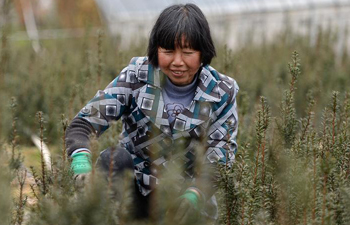WASHINGTON, March 5 (Xinhua) -- A U.S. study showed that permafrost in the coldest northern Arctic, previously thought to be temporarily shielded from global warming, will thaw enough to become a permanent source of carbon to the atmosphere in this century.
Its peak transition will occur in 40 to 60 years, according to the study released by the U.S. National Aeronautics and Space Administration (NASA) on Monday.
A research team led by Nicholas Parazoo of NASA's Jet Propulsion Laboratory calculated that as thawing continues, by the year 2300, total carbon emissions from this region will be 10 times as much as all human-produced fossil fuel emissions in 2016.
The study found that warmer, more southerly permafrost regions will not become a carbon source until the end of the 22nd century, because other changing Arctic processes like plant growth will counter the effect of thawing soil in these regions.
Plants remove carbon dioxide from the air during photosynthesis, so increased plant growth means less carbon in the atmosphere.
However, the colder northerly region would transition sooner than the warmer ones. The model simulations showed that northern permafrost lost about five times more carbon per century than southern permafrost.
Permafrost is soil that has remained frozen for years or centuries under topsoil. It contains carbon-rich organic material, such as leaves, that froze without decaying.
As rising Arctic air temperatures cause permafrost to thaw, the organic material decomposes and releases its carbon to the atmosphere in the form of greenhouse gases such as carbon dioxide and methane.

















